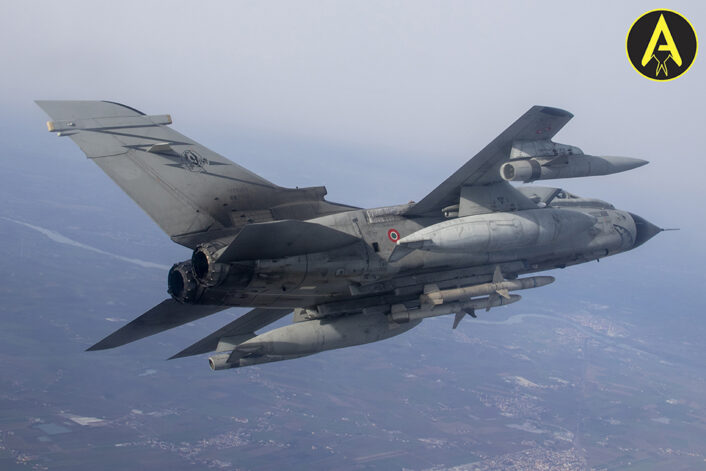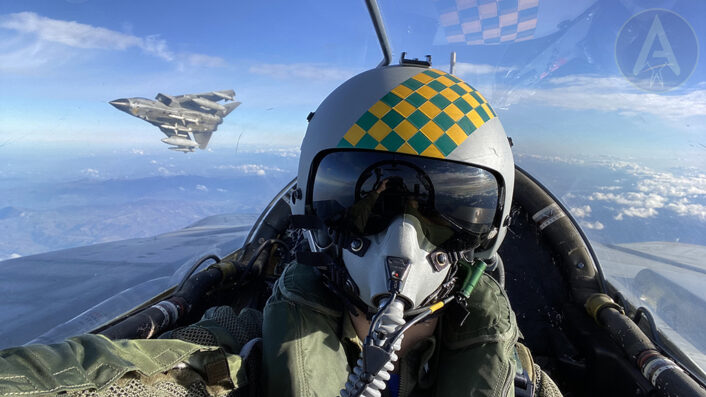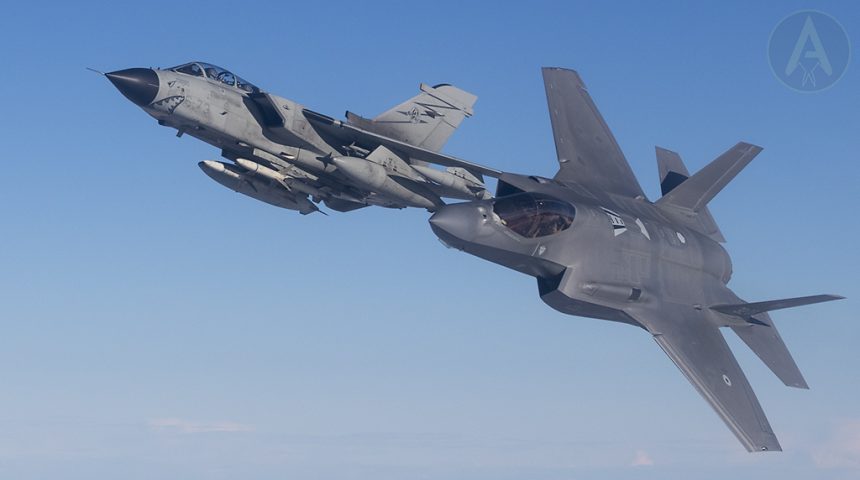We had the unique chance to see how the Italian Tornado ECRs team up with the F-35s to carry out a SEAD mission.
“Wild Weasel” is a code name given by the United States Air Force to an aircraft of any type, equipped with anti-radiation missiles and tasked with the SEAD (Suppression of Enemy Air Defenses) mission: destroying the radar and Surface-to-Air Missile installations of enemy air defense systems. Within the Italian Air Force, the Wild Weasel mission is assigned to the 155° Gruppo ETS (Electronic Warfare Tactical Suppression) “Pantere Nere” (“Black Panthers”) of the 6° Stormo (Wing) based in Ghedi Air Base, northern Italy. The squadron operates with the Tornado ECR MLU RET8.
Just like the IDS fleet, that will officially celebrate its 40th anniversary in September this year, the Tornado ECR have, over the years, been modernized since they were first inducted into active service. Between 2013 and 2018, 15 Tornado ECRs were upgraded to the RET8 standard as part of a Mid-Life Update that introduced new avionics sub-systems and a new mission software, and required changes to the weapons management system in order to expand the array of armaments and mission loads the aircraft can carry.

Along with the INS/GPSintegrated NAV system aided by a MMR (Multi-Mode Receiver), the Tornado ECR MLU RET8, designated EA-200D in accordance to the Italian MOD Mission Design Series, is equipped with an upgraded IFF system, and Data-link system, with a new NVG-compatible internal and external lighting systems as well as new MFDs (Multi-Function Displays) in both the pilot and navigator’s cockpits.
“Our primary role is SEAD (Suppression of Enemy Air Defenses) and DEAD (Destruction of Enemy Air Defenses), two kinds of mission we carry out with the Tornado ECR,” says Lt. Col. Michele, Commander of 155° Gruppo ETS, as he welcomes us in his office. “In terms of sensors, the ELS (Emitter Location System) is the onboard system that allows us to identify and geo-localise, in a pretty fast and accurate way, the ground radars that can be associated with the enemy anti-aircraft defenses.” Although somewhat similar, SEAD and DEAD missions are quite different: the missile used for SEAD missions can destroy an enemy radar making it unavailable for a certain period of time. However, if a replacement antenna is available, the air defense site can be restored and put back into service in a matter of a few days (if not hours). The DEAD mission aims at destroying both the radar and the launchers so that the SAM site is rendered inoperative for a longer period.
For DEAD missions, the Tornado’s arsenal has been expanded in 2016 with the addition of the GPS-guided GBU-32 JDAM (Joint Defense Air Munition) bombs that complemented the ARM (Anti Radiation Missiles) used for SEAD missions: the AGM-88B HARM and the AGM-88E AARGM (Advanced Anti Radiation Guided Missile). The latter is a follow-on variant of the HARM (High Speed Anti Radiation Missile), developed under a US and Italian joint acquisition programme led by the US Navy. It features new software, improved ability to geo-locate and neutralize the threats thanks to a multi-mode seeker that embeds a passive radar, and an active millimeter wave sensors coupled with a GPS-aided inertial navigation system.

The new missile was introduced after a successful Operational Test & Evaluation (OT&E) campaign, dubbed “Blazing Shield”, that saw four Tornado ECR deploy to Naval Air Weapons Station China Lake, California, in April 2018, to undertake a series of tests and two live firing events. “Although we have received the new AGM-88E, the squadron retains a capability with the AGM-88B: we still maintain the Bravo version as it can be useful is certain scenarios. For this reason we train and fly with both types. For us, the missile is itself a sensor and this is the reason why we fly training missions usually carrying one or two AGM-88s”.

Although a phase-out date has not yet been officially confirmed, the Italian Air Force has already decided that the SEAD/DEAD mission will transition to the F-35A Lightning II when the Tornado ECR is retired.

“The current weapon system still allows us to carry out our mission in an effective way. But we have already started operating jointly with the F-35, that is the future of the Air Force: some of our pilots have already completed the transition to the F-35 and this is important because we are this means that we are pouring some of our experience into the Lightning line.” It’s worth remembering that while it has the ability to locate and track enemy forces, until the AARGM-ER (Extended Range) is integrated on the type, the F-35 still lacks a missile for SEAD missions, although it can use various stand-off weapons, including the GBU-39 SDBs (Small Diameter Bombs) that can be carried inside the weapons bays, to attack ground targets itself. During the transition of the SEAD mission, 155° Gruppo and 13° Gruppo (the squadron that flies the F-35A of 32° Stormo out of Amendola AB) are exploring new ways to exploit the best capabilities both aircraft are able to make available to the Wild Weasel mission.

More details about the 155° Gruppo can be found in the story by this Author “Italian Wild Weasels”, in the July 2022 issue of Combat Aircraft Journal, at newsagents now!
In order to see how the F-35 and the Tornado work together, we were given the opportunity to fly aboard a Tornado ECR during a SEAD mission that involved three Tornados (2 ECRs + 1 IDS) from Ghedi (callsigns PANTE 1-3) and two F-35A of the 13° Gruppo of the 32° Stormo from Amendola (FALCO 31-32). Here’s how it went.
Hunting radars with the Black Panthers
On Feb. 16, 2022 we flew a mission with the 155° Gruppo. The mission was planned to take place inside R48, a restricted airspace located above central Italy, more or less mid-way between the departure airbases of the “Tonkas” and the F-35 Lightnings that joined us to carry out a SEAD mission that could leverage the capabilities of both 4th and 5th generation aircraft. The take-off time was at 13.00Z (14.00LT) with a WALK to the aircraft at 12.00Z so we spent most of the morning in the planning of the mission that, unlike sorties flown with only local assets, also included a Secure Video Conference with the two F-35 pilots from Amendola AB to review the whole plan, including block levels, task sharing and safety measures. For instance, to ensure proper deconflictions, we were assigned block altitudes between FL130 and FL150 (with aircraft separated by 1,000 feet) whereas the F-35s were assigned the block FL160-180. The transit time to the operational area was about 30 minutes, then we had 30-45 minutes “play time” before the RTB phase (lasting another half an hour).

The sensitivity of the mission and the type of assets involved in the sortie don’t allow us to disclose many details about the actual “kinetic” part of the sortie, but what we can say is that the mission was planned so that the F-35s used their sensor cooperating with ECRs in order to locate and ID the targets, share positions witihin platforms and allow Tornados to employ AGM-88: the two ECRs carried two inert Harm missiles, whereas the IDS, flown by a 155° Gruppo pilot, did not carry any armament but it took part in the mission flying the same mission profile as the rest of the ECR. The mission had a two-fold goal: put the SEAD/DEAD tactics to test and improve the 4th/5th generation cooperation. Among the various possible scenarios, a SEAD mission jointly carried out by the two types can see an initial phase where F-35s use their ESM (Electronic Support Measures) capabilities cooperating with ECRs to detect the emissions of the enemy radars, gather the EOB and pass the relevant targeting information to the Tornado ECRs in order to employ AGM-88 from outside the envelope of the SAM batteries. The traditional “Magnum” codeword (used since the first Gulf War by the SEAD aircraft upon firing their anti-radiation missiles) is radioed to announce the launch of an AGM-88.
As said, we can’t provide many more details about the mission other than saying that it was “successful”.
“The integration with the F-35 is crucial. We exploit the F-35’s sensor fusion and the ability of the 5th generation aircraft to disseminate the information to us via Link 16.” Lt. Col. Michele’s words are echoed by the F-35s pilots we had the opportunity to talk to: “The SEAD/DEAD capability is the F-35’s core business. The pilots of our squadron have already gained an enormous experience in the use of the aircraft in this kind of mission, that is part of the training of an F-35 pilot since the very early stages of the training process.” Simulated SEAD/DEAD missions that see the integration of the Tornado ECRs and the F-35s are flown quite frequently. “We train for this kind of mission with legacy assets whenever we have the opportunity. The training profile of the F-35 pilots includes a specific mission that embeds Fighter Integration tactics during which the two assets cooperate using two different air-to-surface weapons”.










